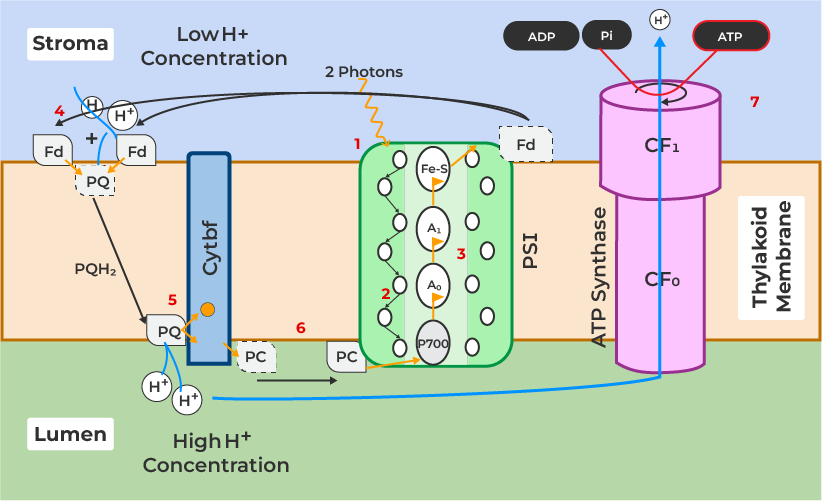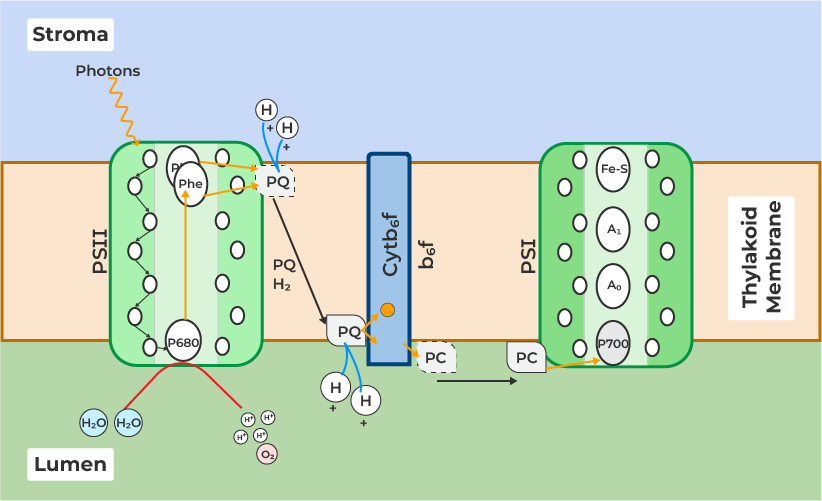The process by which plants convert carbon dioxide, water, and sunlight into oxygen and energy in the form of sugar is known as photosynthesis. Autotrophic plants produce their own food through a process called photosynthesis. Sunlight, chlorophyll, CO2, and water are four crucial components needed for this process. The two paces of photosynthesis are the Light Reaction and the Dark Reaction.
Light Reaction
In the presence of light, this phenomenon takes place. As the pigment absorbs light, ATP is created, which is energy. The process includes light absorption, water splitting, oxygen release, and the production of ATP and NADPH. Two photosystems, PS-I and PS-II, both contain light-harvesting complexes made up of protein-bound pigment molecules. Each photosystem consists of antennae carrying auxiliary pigments and a reaction centre made up of chlorophyll a molecule. The reaction centre for PS-I is at P-700 because chlorophyll has an absorption peak at that wavelength, while PS-is II’s at P-680 because it has a different absorption peak.
Dark Reaction
This process occurs not in the presence of light in the stroma of the chloroplasts. The following cycles are involved in the process: the C3 cycle and the C4 cycle. The Dark reaction is called the carbon-fixing reaction.
Photophosphorylation
Through the activation of PSII, photophosphorylation uses solar energy to convert ADP to ATP. In this, a process known as photolysis splits the water molecule into oxygen and hydrogen protons (H+). An ongoing, unidirectional flow of electrons from water to PS I is then carried out. Through the action of the enzyme ATP synthase, ATP is produced, and electrons travel spontaneously from donor to acceptor through an electron transport chain. A chain of redox reactions known as an “electron transport chain” sequentially transfers electrons from a high-energy molecule (the donor) to a lower-energy molecule (the acceptor).
The flow of protons from the stroma to the thylakoid space creates a transmembrane electrochemical potential gradient during the operation of the electron transport chain. This proton gradient is established as the power for ATP synthase activity, and ATP is subsequently produced by phosphorylation. Photophosphorylation is of two types:
- Non-cyclic photophosphorylation.
- Cyclic photophosphorylation.
Cyclic Photophosphorylation
Photophosphorylation in a cycle. Cyclic photophosphorylation is the name given to the photophosphorylation procedure that leads to the cyclic movement of electrons during the synthesis of ATP molecules. In this procedure, plant cells only convert ADP to ATP to provide the cells with immediate energy.

Reactions of Cyclic Photophosphorylation
Steps of Cyclic Photophosphorylation
These are some steps in cyclic photophosphorylation:
Light hits Photosystem-l
At the start of the cyclic photophosphorylation process, PS I is hit by a photon, a particle with a quantum of light energy The PS I’s colours absorb the energy.
Accessory pigments of PS I -> P700 reaction centre
The pigment supplies energy to the P700 reaction centre. P700 reaction electron gets restored to higher energy by absorbing energy. single electron lost from the P700 reaction centre.
P700 to ferredoxin
The electron of the P700 reaction centre is unstable.P700 reaction centre’s electron jumps out of its higher energy orbital and is captured by chlorophyll A0, from molecule A0 goes to molecule A1, which has a higher potential than AO, a cluster of iron and sulphur will now get the electron that was formerly in molecule A1. Fe-S releases the electron, which is then caught by Fd or ferredoxin. The stroma and the thylakoid membrane have water-soluble protein fd. This protein moved. The electron of P700 moved from P700 to fd molecule.

Path of electrons from P700 to ferredoxin
Ferredoxin -> Plastoquinone
Ferredoxin is an electron carrier. It transfers electrons from the Fe-S complex to PQ through the stroma.
Plastoquinone -> Cyt b6f
Two hydrogen particles are moved by PQ or plastoquinone, it additionally requires 2e-. Each particle, including P700, Fd, PQ, and others, exists in many copies. one extra electron from the P700 moves from PS I to PQ with the guide of one more Fd as the subsequent photon strikes PS I.
Two electrons and two H+ particles (from the stroma). It goes from the stromal side of the thylakoid layer to the lumen side prior to showing up at the Cyt b6f complex. PQ discharges the two H+ particles at the lumen side and moves two electrons to Cyt b6f on the thylakoid layer.
Cyt b6f -> Phycocyanin -> P700
Phycocyanin gets two electrons from Cytb6f. The election travel through the lumen, from Phycocyanin to P700. The two-electron deficits in the two P700 reaction centres are compensated for using two electrons. Currently, the two P700 RCs are operating normally.
Chemiosmosis
Ions move over a selectively permeable membrane along their electrochemical gradient is called Chemiosmosis. Higher H+ ion concentrations are found in the lumen and lower H+ ion concentrations are found in the stroma. The incursion of H+ ions during the electron transport by pq. ATP synthesis transport of these H+ ions. ATP synthase produces ATP. Because the released electrons in this photophosphorylation come back to the PS I, it is known as cyclic photophosphorylation.

Cyclic Photophosphorylation
Non-Cyclic Photophosphorylation
Photophosphorylation without a cycle. Non-cyclic photophosphorylation is the title given to the photophosphorylation process that causes the electrons to move non-cyclically in order to synthesise ATP molecules using the energy from excited electrons moved by photosystem II.

Non-Cyclic Photophosphorylation
Reactions of photosystem I
PS I includes a P700 reaction centre and a bunch of accessory pigments. The following reactions are associated with PS I (photosystem I).

Reaction in photosystem I
Photon hits PS I (Photosystem-l)
One photon falls on photosystem I. The photon’s energy is moved to the pigments in the PS I.
Photon -> P700
The pigments retain the energy of the photon and begin vibrating. These vibrations are given starting with one pigment molecule onto the next until the energy in the vibrations is given to the P700 response focus. The peripheral e–of P700 retains power and gets excited to a higher energy level.
P700 -> Ferredoxin (Fd)
The P700 reaction centre’s higher energy orbital electron releases it, and another modified chlorophyll molecule accepts it. The electron to the A1 molecule has a more significant potential. The electron formerly in molecule A1 will now go to an iron-sulfur complex (Fe-S). decrease capability of the Fe-S complex is lower than that of ferredoxin, the following protein (Fd). Accordingly, Fd takes the electron that Fe-S gave up.
Ferredoxin -> Ferredoxin NADP+ oxidoreductase (FNR)
Fd is a small and water-soluble protein. Subsequent to acquiring the electron, ferredoxin (Fd) travels through the stroma to reach the electron acceptor, FNR. A catalyst called FNR catalyzes the change of one NADP+ into NADPH by moving two electrons from two Fds. The NADP+ gains these two electrons. It becomes NADPH now. NADPH is an electron transporter.

The activity of FNR (Ferredoxin NADP+ oxidoreductase)
Reactions of photosystem II
PS-l was discovered first later PS-ll was discovered.

Reactions in photosystem II in non-cyclic photophosphorylation
Photon hits PS II
When a photon strikes photosystem II, accessory pigments take it in and absorb it.
Photon -> P680
Energy pass from the photon to the P680 reaction centre.
P680 -> Pheophytin (Pheo)
Comparing P680 to the following protein in the cascade, pheophytin, reveals that P680 has a larger redox potential due to the excited electron. As a result, Pheophytin receives the electron while the P680 reaction centre loses the electron.
Pheophytin -> Plastoquinone (PQ)
Plastoquinone is present in the thylakoid membrane. It carries two electrons. A second electron is sent to the PQ protein from a second P680 reaction centre. Plastoquinone, or PQ, is converted to PQH2 by taking two pheophytins and two hydrogen ions from the stroma.
Plastoquinone -> Cytochrome b6f
B6f covers the thylakoid membrane. Two H+ are released into the lumen and two electrons are moved to Cyt B6f once PQH2 reaches there.
Cytochrome b6f -> Phycocyanin
The electron transfer to the next protein. Cytochrome b6f loses the election and phycocyanin gains the electron. Phycocyanin has two electrons present in the lumen. Pc gives an electron to P700. Two electrons from the Cyt b6f are utilised to satisfy the shortage of two electrons in the two P700s. There is an electron shortage in the two P680 reaction centres. The two P680 reaction centres receive their electrons from photolysis, the splitting of water molecules brought on by light. Now let’s see what is referred to as water photolysis.
Water Splitting
Photolysis is the term for the light-dependent splitting of water. Manganese and chlorine both play significant roles in the PS-II process that is connected to this one. The electrons created during this procedure take the place of the electrons lost from P680. As a result of P680 absorbing light, a water molecule splits to liberate oxygen.
2H2O —–> 4H+ + 4e– +102
Number of electrons and protons
On both photosystems, 4 photons were employed instead of 2. As a result, all four electrons are utilised. Thus, 4 photons are consumed at photosystem-I and photosystem-II and 4 electrons move through both photosystems to produce 1 oxygen molecule.
Similarities between Cyclic and Non-cyclic Photophosphorylation
- When photosynthesis occurs, both cyclic and noncyclic photophosphorylation take place.
- There are two types of photophosphorylation i.e. cyclic and noncyclic.
- Light is required for both cyclic and noncyclic photophosphorylation.
- ATP is produced by both cyclic and noncyclic photophosphorylation.
Difference between Cyclic & Non-cyclic Photophosphorylation
|
Cyclic Photophosphorylation
|
Non-Cyclic Photophosphorylation
|
| Photosystem I experience it. |
It can be seen in both photosystems I and II. |
| The only product is ATP. |
ATP and NADPH are generated. |
| Electrons that the photosystem expels and then absorbs. |
Electrons that are ejected by the photosystem but do not reenter. |
| Water does not undergo photolysis. |
Water is subject to photolysis. |
| No oxygen is released. |
Release of oxygen. |
FAQs on Cyclic and Non-Cyclic Photo-photophosphorylation
Question 1: What are two types of photophosphorylation?
Answer:
There are two types of photophosphorylation which is cyclic photophosphorylation and non-cyclic photophosphorylation.
Question 2: What is photophosphorylation?
Answer:
Photophosphorylation is the insertion of a phosphate group during the light reaction of photosynthesis when light is present. The term “photophosphorylation” refers to phosphorylation that takes place while the light is present.
Question 3: What is the non-cyclic photophosphorylation process?
Answer:
When electrons are expelled from the exciting photo centre and do not reenter, non-cyclic photophosphorylation takes place. Only when both photosystems I and II are active does this process take place. Electrons are released as a result of the photolysis of water. Consequently, a consistent supply of water is needed for this operation. During this process, ATP and NADPH are both produced.
Question 4: In which case Cyclic photophosphorylation is ideal?
Answer:
Only in the case of bacteria, the cyclic photophosphorylation method is ideal.
Question 5: How many ATP are formed in cyclic photophosphorylation?
Answer:
Cyclic photophosphorylation produces 2 ATP molecules.
Please Login to comment...